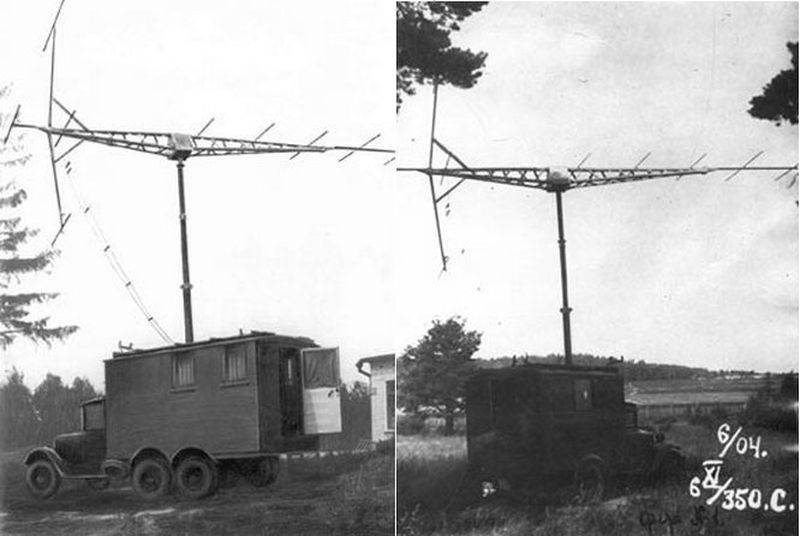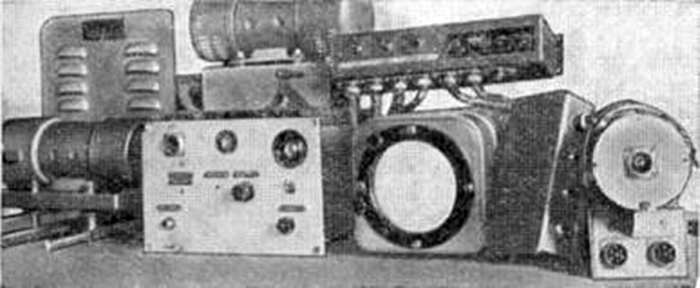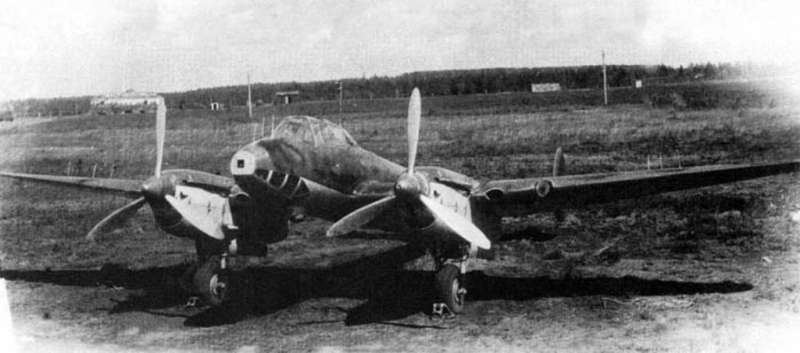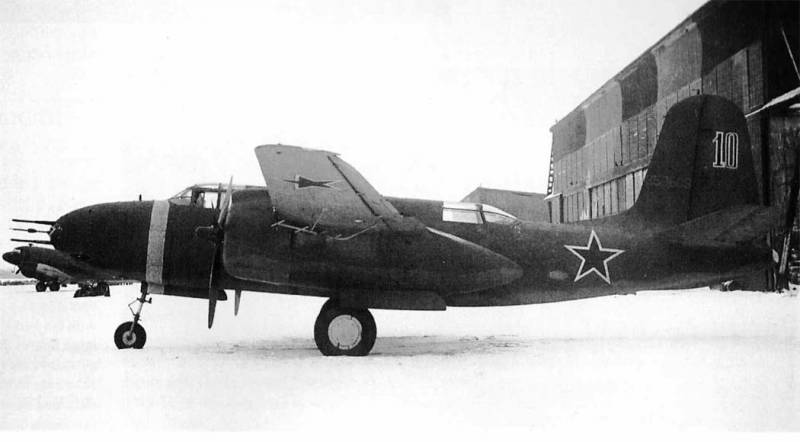"Gneiss-2." The first serial Soviet aviation radar
In 1932, the Red Army Military Technical Directorate handed over orders for the development of aircraft detection tools to the Main Artillery Directorate (GAU) of the People’s Commissariat of Defense. The State Agrarian University, with the consent of the General Electric Power Industry Directorate, instructed the Central Radio Laboratory in Leningrad to organize experiments to test the possibility of using reflected radio waves to detect airborne targets. The contract between them was concluded in 1933 year, and already 3 January 1934, in practice, the aircraft was detected using radar, which worked in continuous mode of radiation. Although the aircraft was able to be detected only at a distance of 600-700 meters, the very fact of detection was a success and contributed to the solution of a further defense task. The experiment conducted in 1934 was considered to be the birthday of Russian radar.
By 1939, a scientific and experimental base was created at the Leningrad Institute of Physics and Technology (LFTI) that dealt with radio waves. At the same time, under the leadership of Yu. B. Kobzarev (in the future academician), a mock-up of the Redut impulse radar was created, in the future, the first production Soviet radar. The creation of this radar station was a significant step forward, since it made it possible not only to detect air targets at long range and at almost all possible heights, but also to continuously determine the azimuth, target flight speed and their range. Moreover, with circular synchronous rotation of both antennas of this station, it could detect single planes and groups of airplanes that were in the air at different distances and different azimuths within their range of operation, tracking their movements with time intervals (one turn of the antenna).
Thanks to several such radars, which were adopted under the designation "RUS-2" (aircraft radio trap), the command of the air defense could monitor the dynamics of the air situation in a zone with a radius up to 150 kilometers (kilometer distance 1,5 kilometer), determining in time the enemy forces in airing and predicting their intentions. Yu. B. Kobzareva, P. A. Pogorelko and N. Ya. Chernetsov were awarded the Stalin Prize 1941 of the year for the scientific and technical contribution to the development of the first domestic early warning radar, which was launched into serial production in 1941.

It is quite natural that along with the creation of the first stationary long-range radar stations, work was carried out in the USSR to create radars that could be installed on warships and airplanes. The development of the first Soviet aircraft radar, which received the designation "Gneiss-2", was already under way in evacuation. The work on the creation of the on-board radar was headed by Viktor Vasilyevich Tikhomirov, who came to work at SRI-20 (today it is the All-Russian Research Institute of Radio Engineering) in 1939 year. He graduated with honors from the institute and rather quickly joined the team of this defense enterprise and took part in the work on adjusting and delivering the first Russian long-range radar, which was adopted into service in 2 under the designation "РУС-1940".
It is worth noting that according to the estimates of the radio industry research institutes, which were performed in 1940, the aircraft radar created on the basis of the technologies of its time, along with cables and power sources, should have weigh no less than 500 kg. The placement of such equipment on board the existing Soviet single-seater fighters was not possible. Moreover, the work of such a radar required continuous maintenance (at the level of development of radio engineering in those years, there was no talk of automating the process), which would distract the pilot from the piloting process itself. The way out of this situation was the installation of an aircraft radar on a multi-seat aircraft. Here, the Soviet engineers did not invent the bicycle, and their British colleagues earlier came to exactly the same solution. At the suggestion of the test pilot of the SRI Air Force S. P. Suprun, the dive bomber Pe-2 could be the carrier of the first Soviet radar, which the Soviet industry switched to at the end of 1940 of the year.
At the beginning of 1941, the operating model of the on-board radar was assembled at the Research Institute of the radio industry, the station received the designation "Gneiss-1". The first Russian aviation radar, quite naturally, turned out to be imperfect and incomplete. In addition, during the experiments and tests, the entire supply of the centimeter-range klystron generator lamp, which was the heart of the on-board radar, was spent, and there was simply no place to order the production of new lamps. The outbreak of the Great Patriotic War forced many Soviet industrial enterprises, including the electrical and radio industries, to be evacuated to the east. Among the evacuees was the developer of klystrons - NII-9. Specialists and equipment of this research institute were scattered in various factories, and the institute actually ceased to exist. The Radio Engineering Research Institute was evacuated, and at the new location in Sverdlovsk it was necessary to restore the necessary test and laboratory facilities.
The evacuation of SRI-20 to Barnaul began as early as July 1941. At the new place, almost from scratch, in very difficult conditions, with a catastrophic shortage of necessary instruments and trained personnel, under the leadership of Tikhomirov, the first Russian aviation radar was created, which received the designation “Gneiss-2”. In just a few months, it was possible to complete the tests of prototypes of the station, which were deemed successful, after which the first on-board radar went to the front.

The pace at which work was carried out on the creation of the first Soviet aviation radar station can be judged from the following facts. The equipment was made without waiting for the full release of the documentation. The installation of the radar station was carried out according to the conceptual scheme of work and draft sketches, while on the move, getting rid of the defects that arise and making changes. As a result of the efforts made, the first “flight” model of the Gneiss-2 radar was ready by the end of 1941. The radiation power of the station was 10 kW, it worked with a wavelength of 1,5 meter.
In January, the 1942 of the year at the airfield, located near Sverdlovsk, radar "Gneiss-2" installed on the bomber Pe-2. Shortly thereafter, the tests of the station began. It is worth noting that the controls and the on-board Gneiss-2 radar indicator were located in the radar operator’s cabin (the navigator had been at that place before), and part of the radar units were installed in the gunner’s cabin. As a result of such changes, the aircraft turned into a double, which somewhat reduced the combat capabilities of the vehicle. In parallel with the evaluation of the performance of the new radar, which at that time was still experimental, there was a process of developing tactics and methods of combat use of aircraft equipped with a radar station. The main role for such an aircraft was the role of a night fighter.
V.Tikhomirov personally headed the works on the creation of the station, E.S. Stein worked with the Air Force on this project. When testing the station as a target was used Soviet bomber SB. Debugging and debugging of radar equipment was conducted around the clock work, the engineers worked directly at the airport. There was a process of checking the antennas of various types, eliminating equipment failures, making changes to the station design. During the work, we managed to reduce the “dead zone” of the radar to 300 meters, and subsequently to 100 meters, and also improve the reliability of its operation. At the same time, the team and management of the SRI-20 understood the importance of creating such a radar. The labor enthusiasm of engineers and ordinary workers during the difficult days of the war, even before the completion of ground tests, released the first series of 15 radar Gneiss-2 for equipment for Pe-2 and Pe-3 combat aircraft. The first combat use of aircraft equipped with a domestic radar took place at the end of 1942, near Moscow.
In July 1942, the Gneiss-2 station was able to successfully pass state tests. The pace of development and commissioning of such a complex product in wartime conditions was impressive. In January, 1942, the first airborne radar installed on the Pe-2, begins the process of testing it. Already at the end of 1942, airplanes equipped with the Gneiss-2 radar take part in combat missions near Moscow, and then participate in the Battle of Stalingrad. 16 June 1943, the station was officially adopted by the Soviet Air Force. In 1946, Tikhomirov received the second Stalin Prize for the development of the Gneiss-2 radar.
During the state tests that ended in July 1942, the following results were obtained:
- the detection range of the bomber-type air target - 3500 meters;
- accuracy of aiming at the target in angular coordinates ± 5 degrees;
- the minimum flight altitude when searching for the enemy - 2000 meters (the minimum height at which problems associated with the reflection of radio waves from the earth's surface disappeared).
At the end of 1942, during the most intense time of the battle of Stalingrad, Tikhomirov with the development team left for the battlefield. Here, the engineers were engaged in the installation and commissioning of the radar on the Pe-2 bombers. Tikhomirov himself often flew as an operator of the Gneiss-2 radar and was personally involved in instructing pilots. The planes equipped by Tikhomirov were used by the Soviet command to block the “air bridge”, which the Luftwaffe tried to provide for supplying various cargoes to the Paulus group surrounded by Stalingrad. Thus, the first Soviet aircraft with radar contributed to the defeat of the Nazis on the banks of the Volga. Acceptance tests of Pe-2 airplanes with the Gneiss-2 radar took place already in 1943, they were held near Leningrad.
In the period from February to May 1943, the aircraft equipped with the Gneiss-2 radar were used in the Leningrad air defense system. They were part of the 24 Guards Fighter Aviation Regiment of the Second Air Defense Corps. When intercepting air targets, night fighters were aimed at the target using ground-based early warning radar RUS-2, and when approaching enemy aircraft they used their own on-board radar. Having discovered the air target, the operator of the Gneiss-2 on-board radar transmitted to the pilot the necessary instructions for rendezvous with the target.
In 1943, in the USSR, an improved version of the radar was created, designated as Gneiss-2M. At this station, new antennas were used, which made it possible to detect not only air targets, but also enemy surface ships. In the autumn of 1943, such a station was tested in the Caspian Sea, after which it was put into service and put into mass production. In total, by the end of 1944, more than 20 Gneiss-230 radar had been created at SRI-2.
From February to June, 1943 was tested by the Gneiss-2 radar with the American A-20 bomber, and the possibility of using it as a night fighter was considered. Compared to the Pe-2 bomber, the lend-lease aircraft had a number of advantages, therefore, in July 1943, the creation of the 56 13th long-range fighter aviation division began. The division consisted of two regiments (45 and 173), armed with A-20 aircraft. Each regiment of the state was supposed to have 32 aircraft and 39 crews, in addition, the regiment consisted of a radar company, which was equipped with an early warning radar ENG-2. This long-range aviation division (ADD) was subordinate. From May 1944, the regiment of the division arrived at the front and were used to provide security for major transportation hubs. In addition to fighting enemy aircraft, aircraft equipped with the Gneiss-2 were also used in mine-torpedo air regiments to detect enemy surface ships.
In addition to its own production Gneiss-2 and Gneiss-2M radars, during the war years American radars were also installed on Soviet aircraft. In total, the US sent more than 54 thousands of airborne radars to its allies, mainly deliveries to the UK. In the USSR, 370 radar stations of two types were supplied: 320 - SCR-695 and 50 - SCR-718. Already after the end of World War II, in the second half of 1945, the Gneiss-5 airborne radar was put into service in the USSR and put into serial production. As a result of state tests, this radar demonstrated the range of detection of air targets 7 kilometers (with the altitude of the target 8000 meters).
Information sources:
http://www.airwar.ru/enc/fww2/pe2gneys.html
http://hist.rloc.ru/lobanov/3_01.htm
Bartenev V.G. Russia is the birthplace of radio. Historical essays
Open source materials


Information